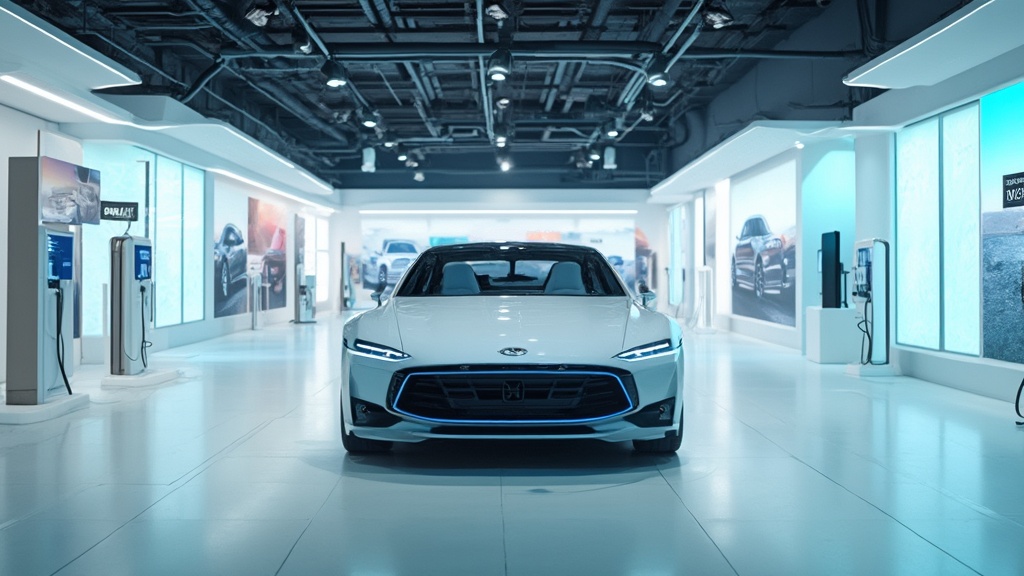Introduction
Electric vehicles (EVs) are reshaping the way people think about transportation, offering a sustainable alternative that aligns with a greener lifestyle. As homeowners consider making the switch, it’s essential to understand not just the environmental benefits, such as:
- Reduced emissions
- Lower fuel costs
but also the practical implications of owning an EV. With the market evolving rapidly, challenges like:
- Range anxiety
- The initial investment
can feel overwhelming. However, the transition to electric mobility can be both rewarding and manageable, especially with the right guidance. This article delves into the various aspects of electric vehicles, from energy consumption and infrastructure needs to the environmental impact and economic considerations, providing a comprehensive overview for those ready to embrace this transformative change.
Introduction to Electric Vehicles: Benefits and Considerations
Electric vehicles (EVs) are more than just a trend; they signify a transformative approach to transportation that aligns beautifully with eco-friendly living. Not only do they contribute to significant reductions in greenhouse gas emissions, but they also reduce fuel expenses and lessen our reliance on fossil fuels. Here at Powercore Electric Inc., we understand that while transitioning to EVs can seem daunting due to concerns like range anxiety and higher initial costs, the benefits are substantial.
As we approach 2024, it’s crucial to recognize that emerging markets are dealing with these challenges, particularly concerning affordable small electric transport models. Many available options tend to be larger, such as SUVs and trucks, which accounted for 65% of total internal combustion engine (ICE) car sales globally in 2023. This statistic underscores the limited availability of smaller models that could appeal to eco-conscious homeowners.
Furthermore, insights from the U.S. Energy Information Administration indicate a shift toward diverse energy sources, with the East Coast beginning to see small volumes of renewable diesel, complementing the growing adoption of EVs. Our services, including:
- Solar panel installations
- Solar battery backups
- EV charging stations
can facilitate this transition, allowing you to charge your transportation sustainably at home. Additionally, case studies on electric vehicle market trends in Europe reveal varied growth—Belgium has seen a significant increase in EV sales while Germany faced a decline, reflecting the complexities of the market.
Recent insights also emphasize the significance of Tesla home chargers and various government initiatives aimed at promoting renewable power solutions. Balancing the benefits of electric vehicles energy consumption against their limitations is key to making informed decisions. As you explore integrating EV technology into your life, consider how it harmonizes with your overall eco-friendly lifestyle, particularly through our solar power solutions, especially in regard to electric vehicles energy consumption.
This holistic approach can maximize both your environmental impact and personal convenience.
Understanding Energy Consumption in Electric Vehicles: Fuel Economy and Influencing Factors
The metric of electric vehicles energy consumption is crucial and is often expressed in miles per kilowatt-hour (miles/kWh), reflecting how efficiently a vehicle utilizes electricity. This efficiency is influenced by various factors, including your driving habits, the terrain you navigate, and even the weather conditions. For instance, aggressive driving can lead to a noticeable spike in power consumption, while smooth driving on flat roads typically enhances efficiency.
Additionally, using climate control features, such as heating or air conditioning, can significantly impact your overall energy use.
To put this into perspective, the Vauxhall Corsa Electric, with its WLTP range of 222 miles and a usable battery size of 48.1kWh, boasts a theoretical efficiency of 4.6 miles per kWh. This efficiency makes it an attractive choice for individuals moving from conventional combustion engines, as illustrated in its case study, which highlights its familiar hatchback design and cost-effective powertrain. Similarly, the Tesla Model Y Long Range AWD has historically been recognized for its efficiency, rated at 276 Wh/mi (or 172 Wh/km).
As Mark Kane notes, this level of efficiency serves as a benchmark for many electric vehicles today.
Comprehending these factors not only assists you in estimating your potential expenses but also directs you in enhancing your driving habits to attain better efficiency in relation to electric vehicles energy consumption. For example, adapting your driving style to be more efficient can help you maximize the miles you get per kilowatt-hour, thereby reducing electric vehicles energy consumption. Furthermore, consider integrating solar power solutions at home, especially for Long Beach renters.
Utilizing solar energy not only improves the sustainability of your transportation usage but also adds to a more environmentally-friendly driving experience. Government programs can help facilitate this transition, making solar panels and home power storage options more accessible and affordable.
Additionally, Long Beach renters can explore solar-powered EV charging stations, which are becoming increasingly available in the area. These stations enable you to recharge your eco-friendly automobile utilizing sustainable power, further minimizing your carbon footprint. For practical steps on accessing these solar power solutions, refer to the “Unlocking Solar Power: Essential Guide for Long Beach Renters to Access Eco-Friendly Solutions,” which outlines how you can benefit from local programs and incentives.
In ongoing conversations, platforms such as A_Camera are providing valuable insights, with 81 replies emphasizing community involvement around consumption metrics for power-driven transports.
Infrastructure Requirements for Electric Vehicles: Charging Stations and Grid Impact
Incorporating battery-powered transportation into your daily routine provides exceptional ease and savings, particularly when you set up a Level 2 charging station at home via Powercore Electric. Our skilled team offers installation services for these stations, which need a dedicated circuit and can be easily positioned in your garage or driveway, enabling you to charge your EV overnight while reducing costs. Public charging stations, particularly fast chargers, are crucial for longer journeys, ensuring you never feel limited on the road.
As battery-powered transportation adoption grows, understanding the impact of electric vehicles energy consumption on the electricity grid becomes essential. For example, Sweden plans to open a permanently electrified road by 2025 and expand its network by 3,000 km by 2045, showcasing significant investments in EV infrastructure. Co-locating renewable power sources near charging hubs not only supports sustainability but also helps manage the electric vehicles energy consumption and alleviates stress on the local power grid.
Nations such as Korea, even after cutting EV subsidies, have pledged to finance charging infrastructure (EVSE), leading to more than 200,000 public chargers set up so far. Such developments reflect global trends in EV infrastructure growth. Additionally, innovations like Electric Road Systems (ERS) illustrate how several nations are enabling charging while driving.
By planning for upgrades to your local infrastructure and considering solar energy options, you can enhance your EV experience and achieve energy independence, reducing reliance on the grid. As you navigate this exciting journey of battery-powered transportation ownership, remember that Powercore Electric is here to guide you towards a cleaner, more sustainable future.
Ready to make the switch?
Contact us now to learn more about our EV charging solutions and how we can help you embrace this transformative lifestyle!
Environmental Impact of Electric Vehicles: Emissions and Battery Production
While electric vehicles (EVs) are celebrated for significantly reducing tailpipe emissions, it’s crucial to take a step back and consider the electric vehicles energy consumption and their broader environmental footprint. The production of lithium-ion batteries, crucial for powering these modes of transport, presents challenges due to the mining and processing of materials, which can adversely impact ecosystems. For instance, global lithium production surpassed 100,000 tons for the first time in 2021, illustrating a substantial increase in demand.
Notably, about 77% of the world’s lithium-ion batteries are manufactured in China, highlighting the concentrated nature of this industry and its environmental implications. Renowned expert Yang Shao-Horn emphasizes the need for change in manufacturing processes, stating,
If we don’t change how we make materials, how we make chemicals, how we manufacture, everything will essentially stay the same.
Fortunately, many manufacturers are beginning to invest in sustainable practices, exploring innovative battery chemistries and more eco-friendly materials.
The case study titled ‘Future of Battery Manufacturing’ showcases ongoing research into these environmentally-friendly materials and processes, underscoring the urgency for change in the industry. Companies like Greenly are leading the charge by helping businesses track their greenhouse gas emissions and develop custom action plans for sustainability, which is crucial for promoting greener practices in battery manufacturing. As you consider the switch to an EV, being aware of both the advantages and the environmental implications of battery production will empower you to make informed choices and advocate for more sustainable practices in the automotive world.
Economic Considerations of Electric Vehicles: Costs and Financial Incentives
When you’re on the journey to owning an electric automobile (EV), comprehending the total expense of ownership is essential. While you might observe that the upfront price tag can be higher than that of traditional gasoline modes of transport, the long-term advantages can be quite compelling. For instance, EVs typically involve lower upkeep expenses and significantly reduced fuel expenditures.
A great way to ease the financial burden is by taking advantage of various federal and state incentives designed to make EVs more affordable. States like California stand out with their generous rebates and tax credits, which can greatly lower the effective purchase price out of your pocket. Moreover, looking at the global landscape, Japan accounted for 31,000 EV sales in 2020, while South Korea saw 54,000, reflecting a growing trend in electric vehicle adoption.
As Consumer Reports emphasizes, if you look at an EV that’s approximately 5 to 7 years old, you could benefit from savings that are two to three times greater than what you’d get from new EVs. Additionally, it’s important to factor in ongoing expenses; AAA estimates the annual cost for EV license, registration, and taxes to be around $984 in 2024. Vehicle registration fees and taxes for electric vehicles can vary significantly by state, so it’s recommended to check with local DMVs for specific estimates and to find out about any state-specific credits or fees.
With these financial details in mind, you can make a smart and informed decision that fits your budget and aligns beautifully with your sustainability goals.
Conclusion
Transitioning to electric vehicles (EVs) offers significant advantages, including reduced emissions and lower fuel costs, making them an appealing choice for eco-conscious homeowners. While concerns like range anxiety and initial costs may arise, these challenges can be navigated with the right information and support.
Maximizing energy efficiency in EVs is essential. Factors such as driving habits and terrain play a crucial role in energy consumption. By adopting efficient driving practices and exploring solar energy options, homeowners can further enhance the sustainability of their electric vehicle use.
Infrastructure is also key to a successful transition. Installing a Level 2 charging station at home simplifies the charging process, while the availability of public charging stations supports longer trips. As EV infrastructure continues to develop, staying informed about advancements can help facilitate this journey.
Additionally, while battery production poses environmental challenges, ongoing improvements in sustainable manufacturing practices provide a promising outlook. Financial incentives available in various regions can help offset the initial costs, making electric vehicles more accessible.
In summary, embracing electric vehicles is a proactive step toward a more sustainable lifestyle. With the right guidance and commitment to eco-friendly practices, the shift to electric mobility can be both rewarding and manageable. Now is the time to explore the benefits and make a positive impact on the environment.


